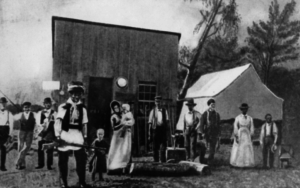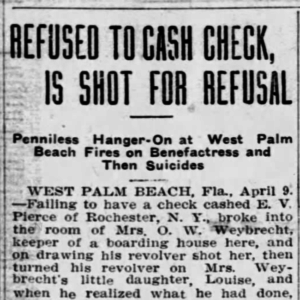Every month during the fall and winter, Janet DeVries Naughton and I conduct cemetery tours at Woodlawn Cemetery in West Palm Beach, Florida. At Woodlawn, many of Palm Beach County’s pioneer citizens forever rest in the paradise they helped tame more than a century ago.
One of the citizens we feature is Otto Wilhelm Weybrecht. Born in 1866 in Germany, Weybrecht came to the United State as a child in 1871. The family had first settled in New York. By the mid 1880s, Weybrecht was working as a plumber and tin smith in Jacksonville. With wife and first child, the family moved to Palm Beach in 1892, and to West Palm Beach in 1893. Weybrecht was one of the first lot buyers on the newly minted plat for the town of West Palm Beach. He bought a lot on the south side of Clematis, where the Harris Music Loft now sits.
Weybrecht built a 22 by 10 foot wooden building to house his dry goods store and tin smith shop, the first store on the peninsula between Fort Pierce and Miami. The family lived in an adjacent tent. The opening was captured in a famous photo that is often seen in publications, with Seminole Indian Billy Bowlegs. The store burned in 1896 in a fire that consumed most of the wooden buildings on Clematis Street.
Several Weybrecht family members are interred in Woodlawn. During the tour, I noticed daughter Louise Weybrecht had died in 1910, a branch adorning her head stone, bearing the inscription “Our Louise.” She was but 12 when she lost her life. I had assumed that a childhood illness had taken her life, as unchecked disease was so rampant. Curiosity about Mr. Weybrecht revealed a much grimmer fate for poor Louise. She had been murdered.
Mary Weybrecht, Otto’s wife, ran a winter boarding house in a building Otto constructed in 1905. The building was located at what today is 422 Clematis Street, just west of the Dixie Highway. At that time, the courthouse was located at that corner, in the former school house building. Next door was another boarding house called the Virginia. Mrs. Weybrecht’s boarding house the Ilex housed seasonal workers in West Palm Beach.
A young man, F.V. Pierce, hailing from Rochester, New York, was in South Florida for the winter season. He and a friend were selling “flatirons” (clothing irons heated on a stove) to make ends meet. Pierce was well known in West Palm Beach and Miami as a friendly man of about 30, but became sullen and violent when drunk. Pierce had been arrested in the winter for public drunkenness and fighting; he attempted suicide in the jail cell by cutting his wrist. He owed Mrs. Weybrecht back rent and again found himself penniless. He gave a check to young Louise to take to her mother upstairs, who had laid down not feeling well. He bounded up the stairs after Louise; she attempted to shut the door but Pierce burst through, and shot them both. He then turned the gun on himself, dying instantly from a gunshot to the head. Louise was hit in the abdomen, and Mary in the upper chest.
At that time, West Palm Beach had no hospital. The two were probably treated at the doctor’s house, or at the boarding house. The outlook for Louise was grim as there was little the doctors could do. Louise died the next day, April 10. Mary survived the shooting, and lived on Fern Street until her passing at age 58 in 1919; Otto passed away in 1912 at the age of 48, perhaps never recovering from the tragedy. We know little of Louise, save for a series of articles about a 1909 piano competition in South Florida, where she was one of the top contestants.
Newspaper accounts came from several Florida and national papers, but none from West Palm Beach as the Lake Worth News or Tropical Sun were not preserved. Given the tragedy, and the standing of the Weybrecht family, the community certainly must have been shocked at the tragedy. Her siblings must have carried that burden the rest of their lives; her brother August Weybrecht was the last to pass away in 1991 at age 90. We see the violence in our world today, but even the pioneer days saw their share of tragic death.








Hello…I do have a photo of Louise with my Uncle August and their dog. My mother, Patricia (Harter) Foster was Ella (Weybrecht) Harter’s daughter.